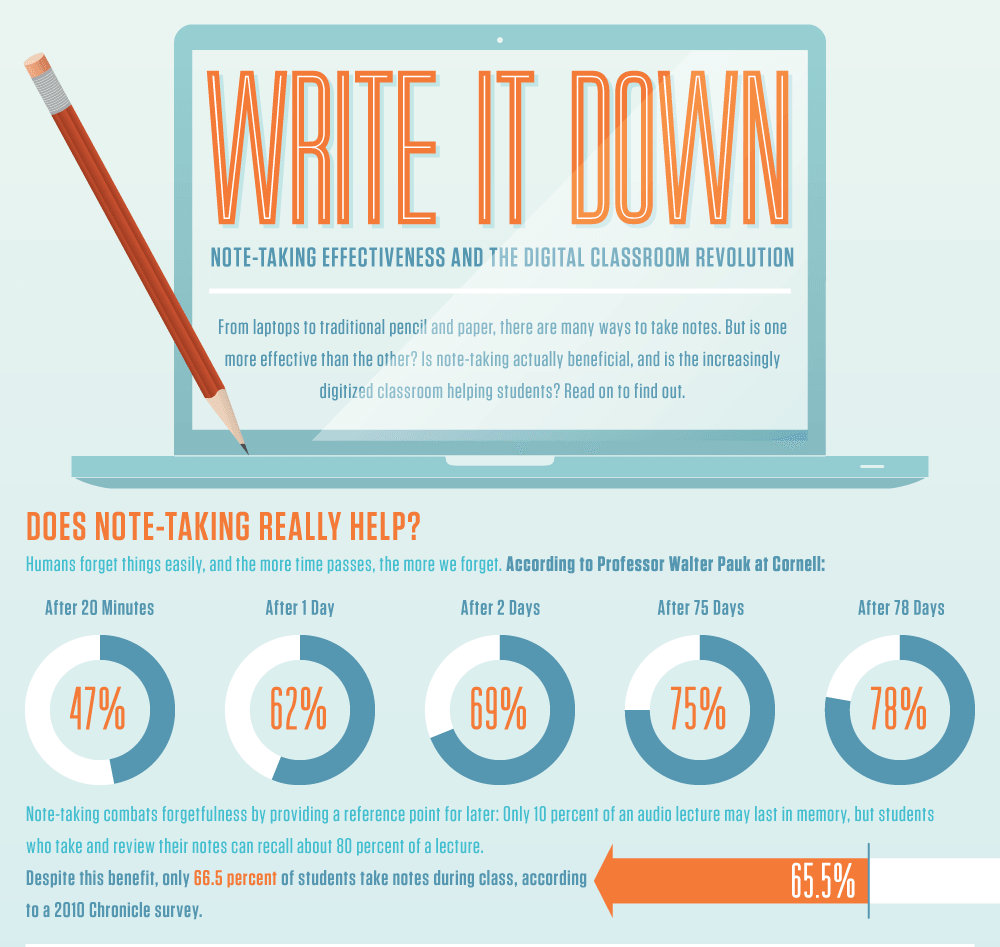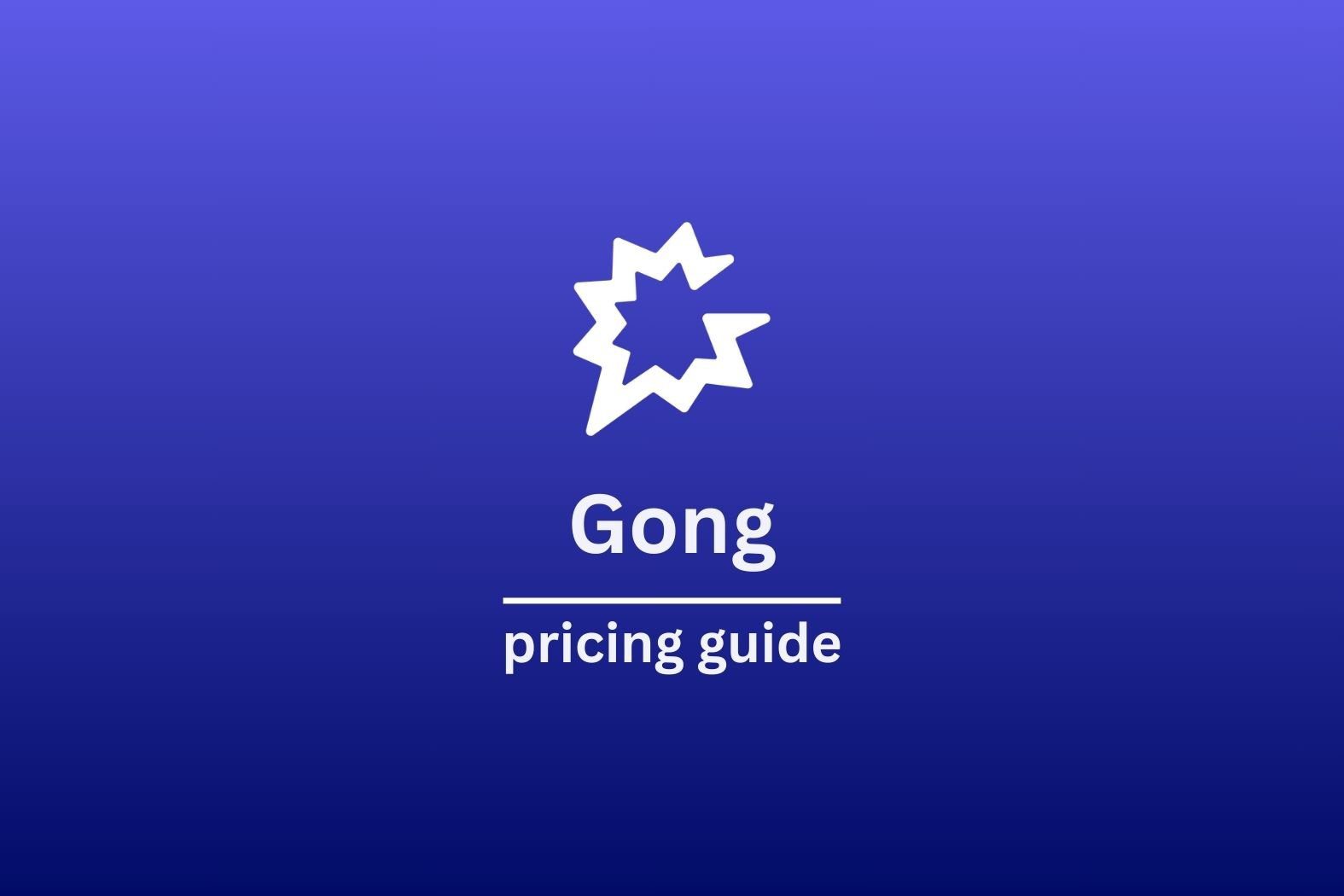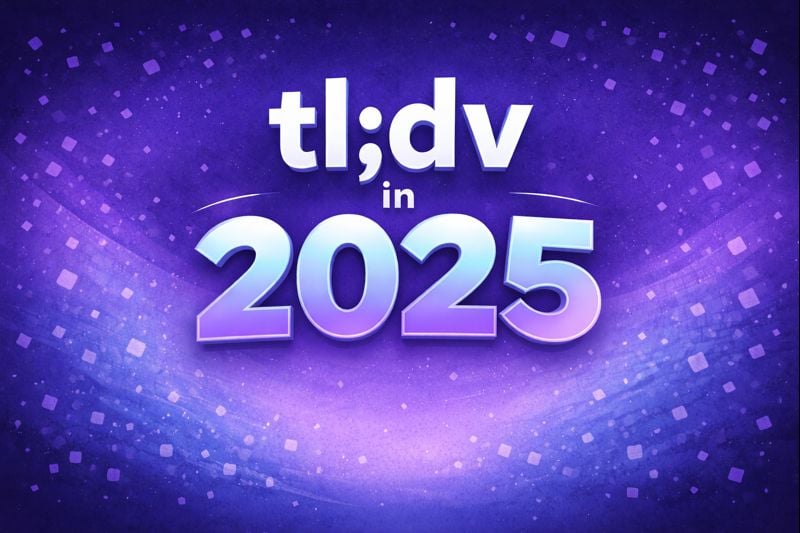Note taking tools will always be crucial for meetings. Scrap that, note taking in general always has been and always will be a crucial part of everyday life. From salesmen to teachers to home bakers jotting down ingredients for a cake, every man and his dog makes notes.
There are old-fashioned note taking tools that people still use today like a good ol’ paper and pen, and then there are state-of-the-art softwares that automatically take notes on your behalf, à la tl;dv. We’re gonna take a look at both digital and analogue note taking tools in this article and see how each tool benefits one of the following:
- Sales
- Customer Support
- User Research
- HR and Hiring
Let’s begin. But before we do, have a look at the importance of note taking in regards to memory with this infographic below.

In a nutshell, humans forget things easily. Note taking is essential for retaining information, and this includes information in business meetings. Below, we’ll take a look at four different sectors and which note taking tools are beneficial for each one. Let’s start with sales teams!
1. Sales Teams
Remembering specific prospect details whilst engaging in a sales call can be a tricky task. You’ll generally want to keep track of the prospect’s wants, needs, and pain points, not to mention any objections they have regarding your product or service. They’ll come in handy for the follow-up calls; that much is certain.
It’s critical that you take notes to keep on the right track with your potential customers, especially when you’re having numerous sales calls every day. Here are some note taking tools that can help you.
Evernote: The World-Renowned Note Taking App
Evernote is an extremely versatile note taking app that utilizes AI-powered features to streamline your note taking. It’s perfect for sales teams, whether they’re making cold calls, follow-ups, or presenting their sales performance metrics to other in-house teams.
Known for its organizational capabilities and ability to capture different data such as notes, images, and recordings, Evernote is an all-round note taking machine. One of its stand out features is its search function, helping users locate key information from their database of notes in mere moments.
In addition to its suite of features, Evernote integrates directly with Salesforce, making your job a whole lot easier. Now your notes can go straight to your CRM without you needing to lift a finger.
Pros
Versatility. It’s a versatile tool that can be used in a wide variety of ways.
Interoperable. It works on multiple platforms and integrates with third-party apps like Salesforce.
Collaboration. You can share notes via collaboration, and all your notes are stored in a cloud-based system ensuring you have them at all times with an extra layer of security.
Cons
Limited free plan. The free plan is limited to 50 notes and has memory size limitations too.
Expensive. The first paid plan costs more than $100 per year, with the higher end plans being more than double that.
Steep learning curve. The interface can be overwhelming and trying to figure out how to use it effectively can be troublesome.
- Lag. It’s reported to be prone to a touch of lag here or there.
tl;dv: The Tool That Makes Selling Easier
tl;dv is one of the best note taking tools for any of the categories we’re discussing here, but sales is where it truly excels. After all, without sales, your business wouldn’t go very far, would it?
There are many reasons why it’s so good at boosting your sales; the most important is that it’s not just a note taker – it’s a video recorder that allows you to rewatch your sales pitches, pick apart your prospect’s body language, improve your sales skills, and even condense dozens of hours of sales calls into a five minute reel (this feature is also fantastic for user researchers when they want to present their findings using the voice of the customer).
You can search every sales call you’ve ever made by keyword to jump straight to the moment in the transcript (or video) where it was mentioned. This is perfect for grouping objections together so you and your sales team can work out solutions for future pitches.
In addition to this, you can get a recurring AI report delivered to your inbox on a regular basis of your choosing about anything you want across any group of meetings you want. It’s all automatic. Your sales team runs the calls for the week, the AI monitors how they handled the specific thing you want to monitor (a pricing objection, for example), and then you read the recurring reports and take action where necessary. It couldn’t be simpler.
Pros
- State of the art AI. tl;dv’s AI can provide recurring reports that cover all your meetings about any topic of your choice.
- Integrations. It integrates with over 5,000 work and productivity tools, including Salesforce, HubSpot, Pipedrive, and more.
- Incredible free plan. The free plan offers unlimited video call recordings and transcripts, letting you get a full feel for the tool without any pressure to sign up.
- Powerful search function. Search a keyword and instantly watch footage from your library of calls where the keyword is mentioned.
- Suite of features. You can edit, timestamp, create reels, and much more.
Cons
- Compatibility. tl;dv is available for MS Teams, Zoom, and Google Meet only.
Microsoft OneNote: Perfect for Sales Team Collaboration
Microsoft OneNote is a digital yet flexible notebook application that helps its users capture notes effortlessly. It’s particularly useful for sales teams as it combines the freedom of taking notes freehand with the streamlining prowess of modern technology. Find out about how to use OneNote for sales management.
OneNote can be used on both a personal or business basis. It stands out from the crowd with its free-form canvas where users can place notes anywhere along the page in collaboration with one another. Sales teams use this frequently, to centralize all the information they want to share with each other.
Pros
- Organization. It’s the perfect app to structure your content easily, using the free form canvas. It also has the ability to create multiple note taking sections, pages, and books which can be used in collaboration with other members of the team.
- Collaboration. OneNote gives you the ability to work with multiple users simultaneously on the same notebook. It’s great for brainstorming and sharing ideas.
- Versatility. The app has the ability to capture all forms of media on the digital notebook. You can also share and organize images, text, doodles, and more.
Cons
- Limited. It doesn’t have some of the features of a more advanced note-taking app.
- Complexity. The features it possesses may have a bit of a learning curve to fully understand how to use the app to its maximum effect.
- Limited handwriting recognition. As it’s not a dedicated handwriting recognition software, the detection can be a little off sometimes.
Whiteboard and Pen: An Old School Classic
As “outdated” as it might be, this deserves an honorable mention. It’s a timeless classic and can be used in almost any given situation. At least, any in-person situation. They’re great for brainstorming in sales meetings among your team members.
There are whiteboards you can use for online meetings, like Zoom’s whiteboard feature, for example, but these are digital versions of the classic.
Pros
- Interactive. Whiteboards are interactive. You can put a whiteboard in the middle of a conference room and get everyone to participate in a great brainstorming session.
- Visual. They’re a great source of visual communication as the whole point is that everybody can see it.
- Flexibility. It’s a flexible and adaptable tool that doesn’t need a subscription like most other note taking tools.
Cons
- Not available for online meetings. A non-digital tool can leave you behind in today’s fast-moving landscape.
- Quality. Notes are handwritten so their legibility might not be clear
- Space. There is only a certain amount of room on a whiteboard. It’s also possible to stain it with marker pens.
- Heavy load. Usually, whiteboards are pretty big so they’re not easily transferable.
Expert Note Taking Advice for Sales Teams
Peter C. Brown – Make It Stick
“People who learn to extract the key ideas from new material and organize them into a mental model, and connect that model to prior knowledge, show an advantage in learning complex mastery. A mental model is a mental representation of some external reality.”
Peter C. Brown, Author of Make It Stick: The Science of Successful Learning Tweet
Make it Stick suggests you recall information by taking notes; ensure the most important points are jotted down in your own words so that you understand it better. Two key techniques are mentioned known as elaboration and retrieval practice. Both encourage the reader to actively take in the message, not just write it down. The book emphasizes the importance of repetition for long-term retention.
However, If you do not have the time to practice these methods, it can be pretty redundant as you won’t learn the methods overnight. Adapting to new techniques may take some time
as it’s not the most straightforward read and features some pretty complex teachings.
If you want a quick summary of retrieval practice, check out the video below.
2. Customer Support
Customer support relies on the ability to listen to the customer, enhance empathy, and solve customer problems. To understand the customer’s concern on a deep level, you can’t be busy making notes. You need to be paying attention.
In this case, you can set up an automated note taking tool to take care of the notes for you, so you can focus 100% of your attention on the customer. By taking notes on your customer support calls, you can improve your customer success and keep track of customer tickets. It also helps you identify and proactively address issues before they get out of hand.
Let’s take a look at some of the best note taking tools for customer support teams, as well as their pros and cons.
FreshDesk: An Intuitive Customer Support Software
Freshdesk is a cloud-based customer support software that offers an abundance of features to help all kinds of businesses manage their customer support effectively. One of the leading ticket systems, Freshdesk is a popular choice amongst business owners. For businesses seeking top-notch customer support solutions, Freshdesk stands out as one of the best IT service management solutions available. With its intuitive interface, automated ticket categorization, and collaborative features like private notes, Freshdesk empowers teams to deliver exceptional customer service efficiently.
It allows customer support team members to collaborate on tickets through the use of private notes. These are only visible by agents logged into your support portal.
Pros
- Easy to use. Freshdesk is easy to use, easy to navigate, and is one of the best user-friendly customer support softwares.
- Automated. Your tickets will be automatically categorized. On each one, you can add internal notes to collaborate with team mates.
- Internal Notes. Notes are completely private and aren’t visible to customers.
Cons
- Cost. It’s a touch pricey if your company is fairly new as you’ll quickly outgrow the free plan. It ranges from $16-$86 per month.
- Complex. The advanced features are complex and you and your team may need training.
- Customer support. Ironically, their customer support isn’t the best in the world.
Unorthodox Note Taking Advice For Customer Support Teams
Gary Vaynerchuk – The Thank You Economy
“The Thank You Economy is not about interrupting customers with advertising and begging for their attention. It's about creating meaningful relationships with customers and earning their attention and trust.”
Gary Vaynerchuk, The Thank You Economy Tweet
Empathy is crucial when working in customer support. You don’t want to search for a short-term fix, you want to cut the problem out at the root, show the customer you care, and increase retention rates. A customer success playbook will help you do this, but it all starts with creating meaningful relationships with customers.
Vaynerchuk’s book is rammed full of teachings that help improve your business over time. It gives you lessons from a scientific perspective to further your understanding of the profile you need to build in order to relate with customers. Its ethos, put simply, is never interrupt your customers, but build a relationship with them!
There aren’t any specific recommendations for note taking tools, but you can read between the lines here. If you’re taking notes manually, you’re going to be distracted. It doesn’t matter how good you can write without looking, if your attention is on writing, your attention isn’t on the customer. Gary Vaynerchuk insinuates that an automated note taking tool is needed in customer support scenarios so you can focus your full attention on the customer and start plugging away at this relationship.
3. User Research
Note taking is a priority for user researchers. They gather important insights into what users like and dislike, and relay it to the relevant teams. A top quality remote UX research tool is essential for taking notes, making recordings, and more.
UserZoom: A Fantastic User Research Software
UserZoom is a UX research software that offers tools to track surveys and other user feedback methods. It guides businesses all over the world to delve deeper into the insights of customer behaviors and it has the most comprehensive range of tools in the UX research sector.
UserZoom also gives you access to UserZoom GO, the quick and easy way to run moderated and unmoderated studies. It comes with a note taking feature that should make your user research notes a lot easier to compile. Each note comes with a timestamp so you can easily jump back to the relevant part of the meeting.
Pros
- Note taking. It has a note taking tool included along with a host of other research tools.
- Automated. UserZoom streamlines your workflow by automating key processes.
- Organized. It’s an efficient platform with great task scheduling, keeping your company on track.
Cons
- Complex. If you’re a bit of a novice in user research software, UserZoom can be a bit daunting to learn.
- Price. It’s pricey if you’re on a limited budget.
Dovetail: The Perfect Tool for Capturing User Feedback
Dovetail is a customer insights platform that helps you manage your user research from a high-level overview. It’s a great tool to streamline your entire research process and capture better insights.
Notes make up the basic unit of information on Dovetail. They can contain video, audio, text, or files. Dovetail’s notes are intentionally flexible so you can figure out the best way to utilize them for your business. In regards to user research, a note can be an entire user interview, or individual highlights from it.
One of the downsides is that it can be quite complicated to learn, especially for stakeholders who might want to view your user research for themselves from time to time. If this is the case, you can check out some Dovetail alternatives.
Pros
- Lots of features. It’s a powerful research machine, with a wide array of analysis tools.
- Collaboration. It’s the perfect application to share ideas and collaborate with your teammates in real-time.
Cons
- Complex. You might run into complications and will probably need guidance to become a proficient user of Dovetail.
- Rigid. Dovetail does have a wide range of features but the app lacks flexibility and personalization.
- Needs the internet. Finally, as it’s a cloud-based app, the internet is a must at all times.
Expert Note Taking Advice for User Researchers
Sönke Ahrens – How to Take Smart Notes
“The most important advantage of writing [notes] is that it helps us confront ourselves when we do not understand something as well as we would like to believe.”
Sönke Ahrens, How to Take Smart Notes: One Simple Technique to Boost Writing, Learning and Thinking Tweet
Writing notes is critical to user researchers. We may feel like we understand the user and their pain points, but unless we actively make a note of it, it’s just going in one ear and out the other. The reality is, if we just listen without taking any notes, most of what was said will be forgotten. And then, critically, we won’t “understand” the user as much as we’d like to think we do.
Notes change everything.
The book has a clear message with actionable insights on note taking, a method known as Zettelkasten. A great emphasis is placed on actively taking in the information you are reading and deepening your understanding. The book has tons of tips and tricks, as well as physical examples of how to get started and take notes efficiently.
Here’s a quick breakdown of Zettelkasten to see if the book’s up your alley!
Thiago Forte – Building a Second Brain
“Your job as a notetaker is to preserve the notes you’re taking on the things you discover in such a way that they can survive the journey into the future."
Thiago Forte, Building a Second Brain: A Proven Method to Organize Your Digital Life and Unlock Your Creative Potential Tweet
Notes that still hold meaning weeks or months into the future are the ones that you need to be making. This applies to user research specifically because of the need to gather copious amounts of information to create a data-driven presentation that hopefully steers the product development team to create something your users will love!
If your notes are too loose and fast, you run the risk of letting the meaning escape. This is why tools that also record your user interviews are even better, as you can timestamp moments that you want to return to and you’re instantly getting the exact same customer insight as when you first saw it. There’s less of a need for you to waste brain space storing it as the whole memory is saved for you.
Thiago Forte’s book is well worth a read if you want to develop techniques to help you build a “second brain”.

The No-Bullsh*t Guide on How to Conduct User Interviews
Has your mind drawn a blank on how to conduct user interviews? We guess you’ve been furiously typing it into Google to have landed here. Woo, check you out being all proactive! Now, you obviously
4. Interviewing Candidates for a Job
Note taking is essential during a hiring campaign. You need to remember key points about different candidates, and what better way to do it than to make notes? With the right digital interview tools, you can streamline the recruitment process and make your job easier. Let’s take a look at a few note taking tools to use when hiring…
Notion: A Versatile and Effective Organization Tool
Notion is a complete combination of note taking, project planning, task management, and collaboration software all on a single platform. It’s a useful tool for interviewing as it offers the ability to customize databases for each candidate during the hiring process. Notion has great editing features for notes and it’s easy to format them with a few clicks of a button.
You can find detailed guides on how to take notes in Notion online, and once you get the swing of it, you’ll want to keep using it. That’s because it’s a great organization tool in general, even without the notes.
Pros
- Versatility. Notion is an all-rounder, allowing you to do many things in one easy-to-use platform.
- Organized. Notion makes it easy for you to organize practically anything, including the notes you made during your interview process.
- Compatibility. It’s a multi-platform application, meaning you can access it via mobile, desktop, or laptop, any place, anytime, and even offline.
Cons
- Complex. It may be more difficult to use than new users expect.
- Awkward navigation. New users may struggle to find their way around Notion as it can be quite overwhelming.
Pen and Paper: A Timeless Tradition
Pen and paper doesn’t need any introduction. It’s the duo that dates back centuries, but they’re just as useful now as they were back then. Sure, you can’t seamlessly send handwritten notes to your CRM, but you can write what you want, when you want, where you want. It’s private and organized entirely by you (which can be both good and bad).
It certainly has its flaws, especially if used during an interview as you might miss important insights. However, it’s probably the easiest to use and the note taking “tool” with the flattest learning curve.
Pros
- Simple. It’s nice and easy to use.
- Retention of information. Using a pen and paper is better for retention of information during an interview.
- No technical problems. No technical problems can arise as it’s purely physical.
- Flexibility. There is complete flexibility to write or draw anything necessary at the moment.
- Secure. You can’t hack into a notepad.
Cons
- Not clear. It’s handwriting and not everyone can read each other’s (or their own after a few weeks).
- Lacks organization. Hastily scrawled handwritten notes are pretty difficult to organize efficiently.
- Waste. It’s not the most environmentally friendly thing in the world.
- Focus. When you’re manually writing notes, are you really focused on the conversation or interview?
- Leaves a lot to memory. You might miss parts while jotting notes, whereas recording the meeting with an online meeting software can capture the footage too.
Expert Note Taking Advice for the Hiring Process
Ryder Carroll – The Bullet Journal Method
“The more content you try to capture during a lecture or a meeting, the less you're thinking about what's being said. You burn through most of your attention parroting the source.”
Ryder Carroll, The Bullet Journal Method Tweet
The Bullet Journal Method hones in on the simplicity of note taking during meetings and how to bullet point effectively to avoid information overflow. It encourages readers to create visuals that relate to their thought processes when taking notes. After all, 40% of all learners respond better to visual information than text alone.
If you want a good way to do this, The Bullet Journal Method is the place to start. It sets you up with the best organizational process for your note taking, improving your general self-awareness and helping you focus your attention on what’s important – the candidate you may or may not be hiring.
While the concept is simple, perfecting the arts of the method isn’t easy and learning new techniques will take some time to digest. If you can’t stay consistent with this format due to time constraints, it will be harder to spot the benefits. Consistency is key.
Locked, Loaded, and Ready to Take Notes
After diving into numerous note taking tools, we hope you feel equipped for your next note taking session. Remember, you aren’t limited to physical tools anymore. There are countless applications you can use to streamline your note taking process, but sometimes a good ol’ fashioned pen and paper trumps all. Having said that, times are changing and if you want to maximize efficiency, AI note taking tools are the way to go.
As Grant Cardone says, “Note taking isn’t just about recording information; it’s about actively engaging with ideas. It’s the difference between passively consuming and actively digesting.”
Are you actively digesting the information in the notes you make? Or are you just passively consuming? Something to ponder over…





